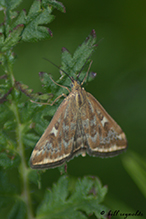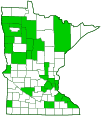Beet webworm moth
(Loxostege munroealis)
Conservation • Description • Habitat • Ecology • Distribution • Taxonomy
| Hodges # | 5004 |
||
Conservation Status |
|||
| IUCN Red List | not listed |
||
| NatureServe | NNR - Unranked SNR - Unranked |
||
| Minnesota | not listed |
||
Description |
Beet webworm moth is a common, medium sized, roughly triangular (deltoid) moth. It occurs throughout the United States and southern Canada, but it is mostly absent from the southeast. Adults are active from May to September. They are found in fields, gardens, and waste places. The larvae feed on the leaves and tender stems of many species of broad-leaved herbaceous plants, including wormwood, lambsquarters, and clover. They are a pest of many agricultural crops, attacking the leaves of soybeans, sunflowers, tobacco, flax, and oats, and damaging the roots of sugar beets and carrots. They also attack many garden plants, including lettuce, spinach, onion, and bell pepper. Adults are ½″ (13 mm) in length and have a 15⁄16″ to 1⅛″ (24 to 29 mm) wingspan. The body is slender. The sensory mouthparts (labial palps) are moderately long and are projected forward. The compound eyes are large. The simple eyes (ocelli) are small but well developed. The forewing is broadly triangular. The ground color is variable, light brown, grayish brown, yellowish brown, reddish brown, or dark brown. The markings consist of pale gray spots and lines and dark blotches. They are variable in number and intensity, and they are sometimes almost completely absent. The discal spot is whitish. The round spot in the upper median area (orbicular spot) and the kidney-shaped spot (reniform spot) in the lower median area have broad dark borders, and they are separated by a pale, rectangular patch. The postmedial (PM) line is yellowish and very wavy. The subterminal (ST) band is yellowish and it is abruptly expanded near the middle. The fringe is also variable. It may be gray, brown, or black. It can be pale at the base, dark in the middle, and pale at the tip, to almost entirely dark. |
Size |
Total length: ½″ (13 mm) Wingspan: 15⁄16″ to 1⅛″ (24 to 29 mm) |
Similar Species |
Alfalfa webworm moth (Loxostege cereralis) forewing has black wedges, lines, and streaks. The |
Habitat |
Fields, gardens, and waste places |
Ecology |
Season |
May to September |
Behavior |
|
Life Cycle |
|
Larva Hosts |
Many species of herbaceous plants |
Adult Food |
|
Distribution |
||
|
Sources 21, 24, 29, 30, 71, 75, 82, 83. Biodiversity occurrence data published by: Minnesota Biodiversity Atlas (accessed through the Minnesota Biodiversity Atlas Portal, bellatlas.umn.edu, 9/19/2025). |
|
| 9/19/2025 | ||
Occurrence |
||
|
||
Taxonomy |
|
Order |
Lepidoptera (Butterflies and Moths) |
Superfamily |
Pyraloidea (Pyralid and Crambid Snout Moths) |
Family |
Crambidae (Crambid Snout Moths) |
Subfamily |
Pyraustinae |
Tribe |
Pyraustini |
Genus |
Loxostege |
This moth was formerly treated as Loxostege sticticalis, a species occurring throughout the Northern Hemisphere. It was separated from the Eurasian species due to significant differences in larva morphology. Loxostege sticticalis is now considered “extralimital to North America,” meaning that it does not occur on the continent. |
|
Subordinate Taxa |
|
|
|
Synonyms |
|
|
|
Common Names |
|
beet webworm moth Nearctic beet webworm |
|
Glossary
Ocellus
Simple eye; an eye with a single lens. Plural: ocelli.
Orbicular spot
A circular spot or outline in the upper median area near the antemedial line on the forewing of many moths.
Palp
Short for pedipalp. A segmented, finger-like process of an arthropod; one is attached to each maxilla and two are attached to the labium. They function as sense organs in spiders and insects, and as weapons in scorpions. Plural: palpi or palps.
Postmedial (PM) line
A thin line separating the median area and the postmedial area of the forewing of Lepidoptera.
Reniform spot
A kidney-shaped spot or outline in the lower median area near the PM line on the forewing of many moths.
Visitor Photos
Share your photo of this insect.
This button not working for you?
Simply email us at info@MinnesotaSeasons.com.
Attach one or more photos and, if you like, a caption.
Bill Reynolds |

|
I believe this to be a Beet Webworm moth (Loxostege sticticalis). There are plenty of sugar beet fields up here, but most are 20 miles and better away. |
MinnesotaSeasons.com Photos
|

Slideshows

Visitor Videos
Share your video of this insect.
This button not working for you?
Simply email us at info@MinnesotaSeasons.com.
Attach a video, a YouTube link, or a cloud storage link.
Other Videos

Visitor Sightings
Report a sighting of this insect.
This button not working for you?
Simply email us at info@MinnesotaSeasons.com.
Be sure to include a location.
Minnesota Seasons Sightings


